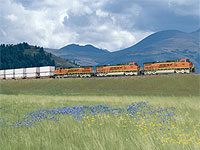|
|
|
Fuel EfficiencyIf just 10 percent of the freight that currently moves by truck were diverted to rail, fuel savings would exceed one billion gallons a year. Imagine getting more than 250 miles to the gallon out of your SUV. It would be possible if your SUV were riding on the rails. Railroads move one ton of freight an average of 423 miles on a single gallon of diesel fuel. They are three times more fuel-efficient than long-haul trucks, in fact. Better yet, over the past 25 years, freight trains have increased their fuel efficiency by 80 percent. But BNSF isn’t stopping there. Since 1996 alone, we've increased our fuel mileage by 11 percent. Fuel-efficient locomotive fleetWe’re conserving fuel by investing in new locomotives that are 15 percent more-fuel efficient. During the past decade, we purchased more than 3,000 environmentally friendly locomotives---more than any of our competitors---and replaced many of our 6,800-engine road and switch fleets. By 2000, we had the newest, most fuel-efficient fleet of all Class I railroads in the United States. Low-torque wheel bearingsInvesting in new, low-torque wheel bearings that require less energy to pull railcars and locomotives has helped BNSF conserve 60 gallons of diesel for each bearing on a car traveling 100,000 miles per year. About half of all BNSF wheels are now equipped with low-torque bearings, and the rest are being equipped as they’re serviced. Adopting more fuel-efficient operating practicesAdopting more fuel-efficient operating practices---including increasing the length of our trains---is helping us conserve more fuel than ever before. In 2006, the average BNSF intermodal train consisted of about 170 containers or trailers versus just 140 in 2001. In 2007, we were the first railroad to test 10,000-foot intermodal trains to achieve even more operating efficiencies. Training our employees to "think fuel"Our employees work to maintain steady speeds, shut down idling locomotives and keep all of our equipment in top condition to conserve fuel. Our drivers are encouraged to regularly maintain their company vehicles and reduce their idling time. Employees who find new ways to conserve fuel are recognized and rewarded as part of BNSF’s "Every Drop Counts" initiative. Testing alternative fuelsBNSF is the only rail carrier in the U. S. to use low-emissions, liquefied natural gas switch locomotives, one of the cleanest-burning technologies in the country today. In 2007, we became the first railroad to pilot the use of natural-gas hostler trucks to move containers at our Los Angeles Hobart Intermodal facility. Utilizing alternative power sourcesBNSF is an industry leader in the use of alternative power sources, including wind-powered generators and solar-powered switches, which we began installing as early as 1996. Turbines at more than 100 locations collect wind energy used to back up our power system. At our 12-story office building in Topeka, Kansas, recycled energy generated by our data center both heats and cools the facility. |
|
|||||||




